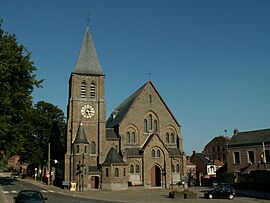Ittre facts for kids
Quick facts for kids
Ittre
|
|||
|---|---|---|---|
|
From top to bottom, Ittre's castle, Saint-Lawrence Church and Saint-Remigius Church
|
|||
|
|||
| Country | Belgium | ||
| Community | French Community | ||
| Region | Wallonia | ||
| Province | Walloon Brabant | ||
| Arrondissement | Nivelles | ||
| Area | |||
| • Total | 34.92 km2 (13.48 sq mi) | ||
| Population
(2018-01-01)Lua error in Module:Wd at line 1575: attempt to index field 'wikibase' (a nil value).
|
|||
| • Total | Lua error in Module:Wd at line 1,575: attempt to index field 'wikibase' (a nil value). | ||
| Demonym(s) | Ittrois(e) | ||
| Postal codes |
Ittre (1460)
Virginal (1460) Haut-Ittre (1461) |
||
| Area codes | 067 | ||
| Website | www.ittre.be | ||
Ittre is a town, also called a municipality, in Belgium. It's located in the part of Belgium called Wallonia, specifically in the province of Walloon Brabant.
Since 1977, Ittre has been made up of three smaller areas: Haut-Ittre, Ittre, and Virginal-Samme. For a long time, Ittre was actually the exact geographical center of Belgium! This changed after World War I. The center moved to Walhain when new lands were added to Belgium.
Contents
A Look at Ittre's Past
Ittre is a very old place with a long history. People believe the village of Ittre existed around the year 640. However, its name first appeared in written records in 877. Even before that, people lived here during the Roman period. There is even evidence of people living here in the Neolithic era, which was the late Stone Age!
How the Villages Got Their Names
The area called Haut-Ittre means "High-Ittre." It's named this way because it's a village that sits above the main town of Ittre.
Virginal might have gotten its name from "Versus Altum." This name was given by the Gallo-Romans, who were people living in Gaul (ancient France and Belgium) during Roman times. They used this name because of Virginal's high location.
Who Ruled Ittre?
Long ago, the land of Ittre belonged to a place called Nivelles Abbey. Later, it was split into several smaller areas, each with its own lord or ruler. The most important of these were Ittre and Fauquez.
The lords of Ittre and Fauquez often argued. They fought over who had control and power in the area and even in the church. These arguments finally ended in the early 1700s.
Some important families ruled these areas. In Ittre, there were the Ittre, Rifflart, and Trazegnies d'Ittre families. In Fauquez, the Ittre, Enghien, Fauquez, and Herzelles families were powerful. Both Fauquez and Ittre were given special titles called "marquisates" in the late 1600s and early 1700s.
Famous People from Ittre
One notable person connected to Ittre was Ambroise-Joseph de Herzelles. He was the third marquis of Fauquez. A powerful ruler named Empress Maria-Theresa chose him for an important job. He became the Superintendent and General Manager of the Finances and Domains of the Netherlands.
Faith and Traditions in Ittre
The church in Ittre was founded around the year 640. It is especially known for the worship of Our Lady of Ittre. This tradition began in 1336 during a terrible plague that spread across the Low Countries (modern-day Belgium and Netherlands).
The Story of Our Lady of Ittre
A statue of the Virgin Mary was carried in a procession from one village to another. When it arrived in Ittre, the plague suddenly stopped! The people of Ittre were so grateful that they refused to return the statue to its original monastery. Even after arguments and court cases, the statue stayed in Ittre.
Because of this miracle, an annual procession was started in 1384. It has been held every year on August 15th without stopping! People especially prayed to Our Lady of Ittre to help with hernias, which are a type of medical problem.
Saint Lutgarde's Relics
Another important saint, Saint Lutgarde, is also honored in Ittre. During the French Revolution, nuns from Aywiers Abbey had to leave their home. They found safety in the Château de Fauquez in Ittre around 1796 or 1804.
The nuns brought with them special items called relics, which are parts of Saint Lutgarde's body or belongings. In 1819, they permanently gave these relics to the church of Ittre.
Important Buildings in Ittre
Ittre has some interesting old buildings, including two large country houses called châteaux. These are the Château d'Ittre and the Château de Baudémont. Sadly, the much grander Château de Fauquez was destroyed in 1827 when the Brussels-Charleroi Canal was being built.
Churches of Ittre
Ittre is home to several historic churches.
St Remigius' Church
This church was built between 1896 and 1899 by architect Clément Léonard. It holds some very special items. Inside, you can find the shrine of Saint Lutgardis of Aywières and the famous statue of Our Lady of Ittre.
St Lawrence's Church
This is a Romanesque church located in Haut-Ittre. Romanesque means it was built in an old style, often with thick walls and round arches. It has kept its original sandstone tower, apse (a rounded part of the church), and central nave (the main part of the church) from that time.
St Peter's Church
St Peter's Church is in Virginal. It was rebuilt in 1827 in a neoclassical style. This style often looks like ancient Greek or Roman buildings. The church has beautiful stained glass windows from 1928, which came from the old glassworks of Fauquez.
Images for kids
See also
 In Spanish: Ittre para niños
In Spanish: Ittre para niños










